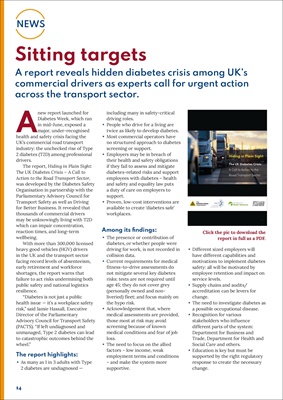
14
NEWS
Sitting targets
A report reveals hidden diabetes crisis among UK's
commercial drivers as experts call for urgent action
across the transport sector.
A
new report launched for
Diabetes Week, which ran
in mid-June, exposed a
major, under-recognised
health and safety crisis facing the
UK's commercial road transport
industry: the unchecked rise of Type
2 diabetes (T2D) among professional
drivers.
The report, Hiding in Plain Sight:
The UK Diabetes Crisis - A Call to
Action to the Road Transport Sector,
was developed by the Diabetes Safety
Organisation in partnership with the
Parliamentary Advisory Council for
Transport Safety as well as Driving
for Better Business. It revealed that
thousands of commercial drivers
may be unknowingly living with T2D
which can impair concentration,
reaction times, and long-term
wellbeing.
With more than 300,000 licensed
heavy good vehicles (HGV) drivers
in the UK and the transport sector
facing record levels of absenteeism,
early retirement and workforce
shortages, the report warns that
failure to act risks undermining both
public safety and national logistics
resilience.
"Diabetes is not just a public
health issue - it's a workplace safety
risk," said Jamie Hassall, Executive
Director of the Parliamentary
Advisory Council for Transport Safety
(PACTS). "If left undiagnosed and
unmanaged, Type 2 diabetes can lead
to catastrophic outcomes behind the
wheel."
The report highlights:
• As many as 1 in 3 adults with Type
2 diabetes are undiagnosed -
Click the pic to download the
report in full as a PDF.
including many in safety-critical
driving roles.
• People who drive for a living are
twice as likely to develop diabetes.
• Most commercial operators have
no structured approach to diabetes
screening or support.
• Employers may be in breach of
their health and safety obligations
if they fail to assess and mitigate
diabetes-related risks and support
employees with diabetes - health
and safety and equality law puts
a duty of care on employers to
support.
• Proven, low-cost interventions are
available to create 'diabetes safe'
workplaces.
Among its findings:
• The presence or contribution of
diabetes, or whether people were
driving for work, is not recorded in
collision data.
• Current requirements for medical
fitness-to-drive assessments do
not mitigate several key diabetes
risks: tests are not required until
age 45; they do not cover grey
(personally owned and nonliveried)
fleet; and focus mainly on
the hypo risk.
• Acknowledgement that, where
medical assessments are provided,
those most at risk may avoid
screening because of known
medical conditions and fear of job
loss.
• The need to focus on the allied
factors - low income, weak
employment terms and conditions
- and make the system more
supportive.
• Different sized employers will
have different capabilities and
motivations to implement diabetes
safety: all will be motivated by
employee retention and impact on
service levels.
• Supply chains and audits/
accreditation can be levers for
change.
• The need to investigate diabetes as
a possible occupational disease.
• Recognition for various
stakeholders who influence
different parts of the system:
Department for Business and
Trade, Department for Health and
Social Care and others.
• Education is key but must be
supported by the right regulatory
response to create the necessary
change.